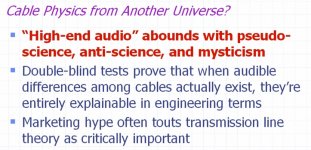Specifically in the latest tutorials, cable structure and his own preferences were mentioned. Listen to the audio tutorial.Mr. Whitlock indeed addresses the connection structures between various grounds and signal lines. A lot can be learned from his explanations. He does NOT discuss type of cable.
If you think his AES papers have anything to do with using RG6U or other cable, you have misread it grandiosly.
jd
The tutorial says different. The basic issue is that ground is not ground as we learn in the textbooks, rather it's a reference line. I have learned from the tutorial.The interconnect ground is effectively in parallel with the power cord grounds. Normally the latter star back to a single circuit/breaker outlet, explaining why the 'miles of wire to the power station' are irrelevant and where the potential for power cord interaction arises.
The tutorial says different. The basic issue is that ground is not ground as we learn in the textbooks, rather it's a reference line. I have learned from the tutorial.
Nomenclature. Yes, I understand that. One learns that lesson quickly trying to silence 150' microphone runs on the 25th floor of newspaper building facing two 50 kWatt AM transmitters two miles away.
Specifically in the latest tutorials, cable structure and his own preferences were mentioned. Listen to the audio tutorial.
You have a link to that tutorial? I have maybe 5 papers from Mr Whitlock, but possibly nr 6 is where it all happened 😉
jd
Last edited:
These two are from the latest (126th) convention.
Created by Camtasia Studio 6
Created by Camtasia Studio 6
Created by Camtasia Studio 6
Created by Camtasia Studio 6
Those are probably among the best explanations that I have read or listened to. I agree with everything in those tutorials except a very small portion of the impedance matching thing.
You need to have a very, very good explanation in order to disagree with anything Whitlock says.
I don't plan to give a whole lecture on this as Whitlock did. But it's a much more complicated issue than what meets the eye. And also dependent on how critical one is, in one's objective. In the real world, there is nothing that fits the ideal voltage transmission model; however, it is true that the closer you get to that model, the less significant impedance mismatching is. I don't think anyone has quantified this in the public media yet.
These two are from the latest (126th) convention.
Created by Camtasia Studio 6
Created by Camtasia Studio 6
Yeah that's what I thought. I actually attended these tutorials.
What I hate is that people here refer to these tutorials as if Mr Whitlock supports there notion of special, magical, transmisdsion line effects.
I find that dishonest to Mr Whilock, and to us, in the extreme.
The slides are clear, but the text is even clearer:
He clearly states, and backs it up with facts, that transmission line effects in audio are 'totally irrelevant', that they only start to occur at > 4000ft cables, and that anybody saying otherwise is 'full of it, up to here'.
But 'marketing loves it'
Can we at least remain intellectually honest?
jd
Attachments
What do you find dishonest? That I don't agree with the impedance matching issues he see irrelevant?Yeah that's what I thought. I actually attended these tutorials.
What I hate is that people here refer to these tutorials as if Mr Whitlock supports there notion of special, magical, transmisdsion line effects.
I find that dishonest to Mr Whilock, and to us, in the extreme.
The slides are clear, but the text is even clearer:
He clearly states, and backs it up with facts, that transmission line effects in audio are 'totally irrelevant', that they only start to occur at > 4000ft cables, and that anybody saying otherwise is 'full of it, up to here'.
But 'marketing loves it'
Can we at least remain intellectually honest?
jd
Concering the transmission line effects, I have not seen any data showing when it starts, so I'd be interested in going through whatever is publically available.
Last edited:
What do you find dishonest? That I don't agree with the impedance matching issues?[snip].
That Mr. Whitlocks presentation which is totally opposite to your ideas is presented as supporting your ideas.
jd
Who did that and where it it posted?That Mr. Whitlocks presentation which is totally opposite to your ideas is presented as supporting your ideas.
jd
it is true that the closer you get to that model, the less significant impedance mismatching is.
And what did Whitlock say? Are you sure you've listened to the whole presentation?
This is where I don't agree with him.And what did Whitlock say? Are you sure you've listened to the whole presentation?
This is where I don't agree with him.
What is "this"? You forgot to mention what exactly you're disagreeing with...
Where did I say it supported what part of my ideas? I would appreciate if you can point it out specifically. I have stated what I don't agree with him on, other than that, I do agree with him.That Mr. Whitlocks presentation which is totally opposite to your ideas is presented as supporting your ideas.
jd
Mr. Whitlock views on the transmission line effects of cable is totally irrelevant in audio. I think cable impedance is an important aspect.What is "this"? You forgot to mention what exactly you're disagreeing with...
Mr. Whitlock views on the transmission line effects of cable is totally irrelevant in audio. I think cable impedance is an important aspect.
Do the math and/or measure that effect in a 3 ft long audio cable. Good luck 🙂
Can we at least remain intellectually honest?
jd
In Audio, are you kidding?
- Status
- Not open for further replies.
- Home
- Design & Build
- Parts
- I don't believe cables make a difference, any input?
